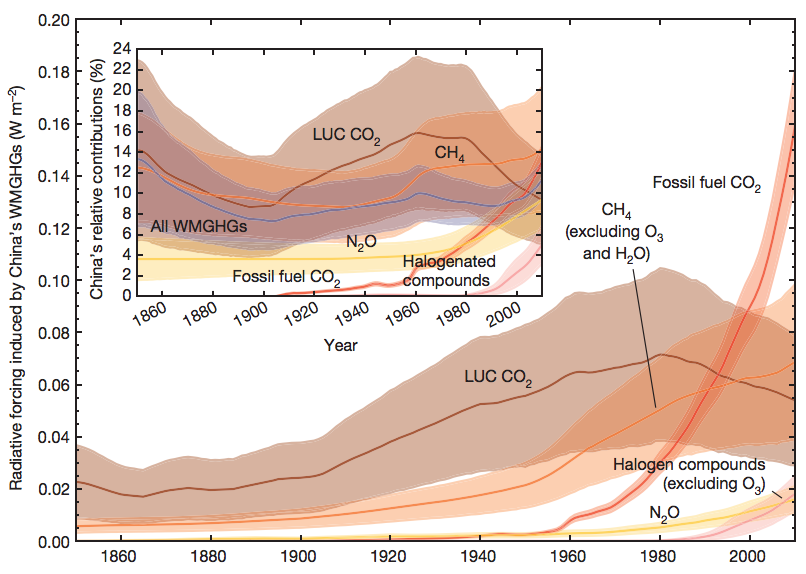
China is responsible for 10% of human influence on climate change, study says
Roz Pidcock
03.17.16Roz Pidcock
17.03.2016 | 6:01pmChina accounts for a tenth of all the greenhouse gases and aerosols that have collected in the atmosphere over the industrial era, according to new research.

Boasting one of the world’s largest economies, China has overtaken the EU and the US as the world’s largest emitter, with CO2 emissions from fossil fuels tripling over the past 30 years.
But despite soaring CO2 emissions, China’s relative contribution to climate change has remained steady – around the 10% mark – over the whole industrial period, says a study published in Nature.
It’s a pretty complicated picture. But in recent times, this is because cooling from aerosols has been masking part of the warming signal. The upshot of this is that cutting some types of aerosol in a much-needed bid to improve air quality could drive faster warming in the coming decades, say the authors.
Climate responsibility
The new study quantifies all the gases and particles currently in the atmosphere that are having an effect on global temperature, and which can be traced back to human activity.
This includes factors that have a warming influence – such as greenhouse gases and black carbon – and those that induce cooling, such as sulphate and nitrate aerosols.
The authors combined this with China’s past and present emissions to estimate, for the first time, the size of the country’s total contribution to human-caused climate change.
Historical warming
Unlike aerosols, greenhouse gases stay in the atmosphere for a very long time. Carbon dioxide emitted at the start of the industrial revolution is still warming the atmosphere today, which is why scientists take into account historical emissions as well as present day ones to work out a country’s contribution to climate change.
The graph below (main, not inset) shows the impact on global temperature – known as the radiative forcing – from different anthropogenic sources of greenhouse gases in China extending back to 1850.

China’s single biggest source of warming is CO2 from fossil fuel burning (red line). With emissions rising steeply over the past few decades, fossil fuels overtook land-use change as the biggest source of CO2 from China in 1992 (brown line).
Warming as a result of changing land use rose throughout the 20th century, before declining in the 1980s as reforestation programmes turned the land from a net emitter to a net absorber.
In a News and Views article that accompanies the study, Prof Dominick Spracklen, associate professor of aerosols and climate at the University of Leeds, says:
Despite this, past emissions from land-use change still account for a third of atmospheric CO2 attributable to China, with fossil-fuel burning making up the other two thirds, the paper notes.
The warming caused by emissions of nitrous oxide (yellow) and halogen compounds (pink) increased over the past two or three decades – to a far lesser extent than fossil fuel CO2, while methane-induced warming increased three-fold between 1950-2010 (orange line).
Relative contribution
To put the changes within China into a global context, the inset graph in the figure above shows the warming effect of Chinese greenhouse gases as a percentage of the global total.
Again, the impact of China’s recent fossil fuel expansion is clear, with the country’s contribution to total global fossil fuel CO2 almost tripling in the 30-year period between 1980-2010.
China currently accounts for 12% of the total greenhouse gases in the atmosphere – a figure that has remained fairly steady over the industrial period, at around 8-12% (blue line). This is effectively the balance of impacts from all China’s greenhouse gas emissions over time – i.e. carbon dioxide, methane, nitrous oxide and halogen compounds – and from all anthropogenic sources.
The 10% figure is lower than might be expected for the country topping of the list of the biggest emitters. But it reflects the fact that others, such as the US and the EU, have been emitting far longer, the paper notes. The paper does not calculate the contributions from these other entities, so a direct comparison is not possible.
Relative to the rest of the world, China’s share of greenhouse gas warming fell slightly in the 1960s, 70s and 80s before starting to climb again as economic growth and fossil fuel burning accelerated.
But there’s something else going on, too. China is responsible for a disproportionate amount of the aerosols emitted around the world, some of which have a strong cooling effect.
Cooling effect
According to the new study’s results, China is responsible for 28% of the sulphate aerosols currently in the atmosphere (light blue bar in the graph below), 24% of nitrate aerosols (dark blue) and 14% of black carbon (pink).

Importantly, while the US and Europe have been slashing sulphates in an effort to improve air quality, China’s aerosol emissions have been on the rise. Spracklen says:
As well as posing a growing public health crisis, sulphate aerosols have a strong cooling effect. Over the past few decades, this has been pulling in the opposite direction to rising CO2, methane and black carbon emissions, effectively muting China’s relative impact on global temperature.
As the graph below from Spracklen’s News and Views article shows, the balance between warming (red shading) and cooling (blue shading) have kept the country’s contribution to human-caused climate change pegged at about 10% in recent decades, despite soaring fossil fuel emissions.

The implication is that if China follows the rest of the world in cutting sulphate aerosols in a bid to reduce air pollution, global temperatures could rise even faster in the coming decades since there would be less of a cooling effect to offset the warming. But this is no reason to avoid doing it, says Spracklen:
But given the upwards trend in fossil fuel CO2 emissions, the long lifetimes of existing infrastructure and the social and political systems in place, it is “unlikely” that China’s relative contribution to global greenhouse gas warming will come down any time soon, say the authors in the paper.
While the study goes further than previous ones in terms of pinning down China’s total contribution to climate change, the authors acknowledge a lot of remaining uncertainty, particularly about China’s methane and sulphur dioxide emissions.
There is also work to be done in completing the complex picture of influencing factors. For example, the authors acknowledge the role of aerosols in stimulating clouds to form and the darkening of snow and ice by black carbon, adding that there is still too much uncertainty to include fully in their calculations.
Main image: View of the Forbidden City shrouded in pollution from Jingshan Park, Beijing. Credit: Stripped Pixel/Shutterstock.
-
China is responsible for 10% of human influence on climate change, study says

